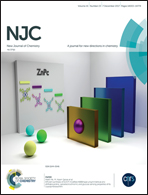Tailored PVDF nanocomposite membranes using exfoliated MoS2 nanosheets for improved permeation and antifouling performance
Abstract
Exfoliated molybdenum disulfide (E-MoS2) nanosheets were synthesized from bulk MoS2. Poly(vinylidene fluoride) (PVDF) was incorporated into E-MoS2 to yield nanocomposite ultrafiltration (UF) membranes by the phase inversion technique. Various proportions of E-MoS2 (0.1, 0.5 and 0.8 wt%) were prepared and were characterized in terms of permeation and antifouling properties. FT-IR and XRD studies confirmed the presence of E-MoS2 in the membranes. Moreover, SEM and FESEM/EDX analysis of the membranes confirmed the increase in the porosity and presence, respectively, of E-MoS2. Atomic force microscopy (AFM) images confirmed that the membrane with 0.5 wt% E-MoS2 exhibited a uniform surface structure with (Ra = 35 nm), compared to the pure PVDF membrane (Ra = 37.6 nm). In addition, the membrane with 0.5 wt% E-MoS2, exhibited higher pure water flux (PWF) (105.1 L m−1 h−1), water content (73.7%), porosity (12.24%), bovine serum albumin (BSA) solute rejection (92.3%), least mechanical stability (1.13 MPa), hydraulic resistance (7.44 kPa L−1 m−2 h−1) and contact angle (72.8°). From all these, it is evident that the overall PVDF membrane performance was enhanced by the E-MoS2 addition, and the membrane with 0.5 wt% E-MoS2 outperformed the other counterparts due to its versatile characteristics and superior potential in the water treatment.



 Please wait while we load your content...
Please wait while we load your content...